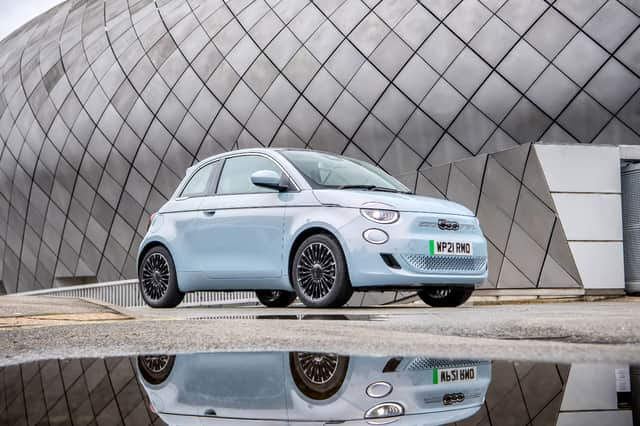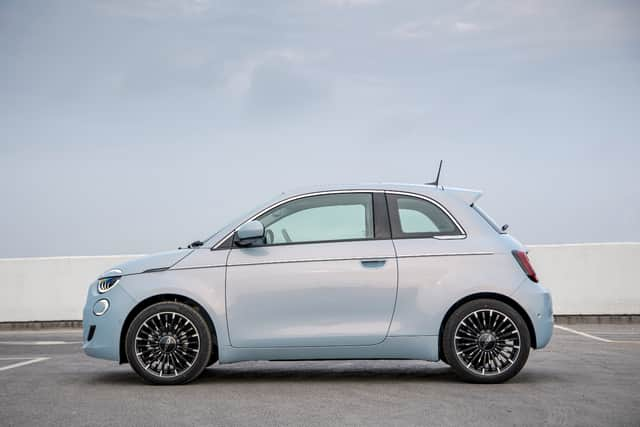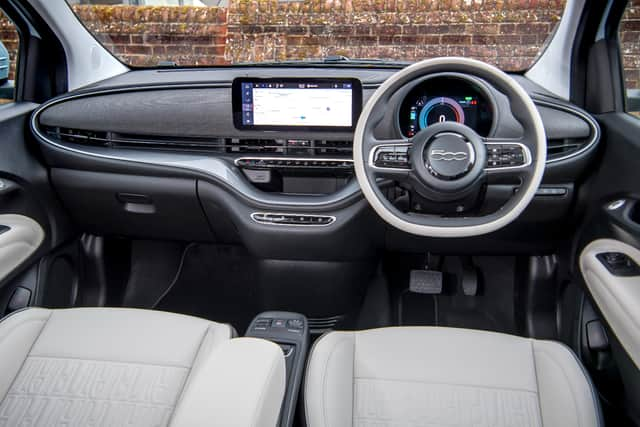Fiat 500 review: electric city car price, range and performance compared with rivals


The rapid shift towards electric cars has seen some unusual changes to how we compare vehicles.
Thanks to pricing and range considerations there’s now a blurring of lines between previously well-defined segments and brands.
Advertisement
Hide AdAdvertisement
Hide AdThat’s particularly true in the family car market, where hatchbacks, estates and SUVs from divergent brands end up competing on price, range or functionality. However, in the world of city cars things are a bit simpler.
There are just a handful of truly compact EVs on the market and even fewer with true kerb appeal.


That’s something that the Fiat 500 has in spades. Replacing a much-loved model is never easy but this all-new and all-electric version manages to maintain the cute retro appeal of its predecessor while giving it a thoroughly modern spin with its choice of electric motors and 21st-century in-car tech.
The first “new” 500 was a smash hit thanks to its unashamedly retro styling and although the latest car is bigger and has less in common with the very first Cinquecento, its connection to its predecessors is clear.
Advertisement
Hide AdAdvertisement
Hide AdIt has a clean, smooth design that is at once instantly recognisable but moves the 500’s look on, making it fresher and more modern. With its simpler lines and broader stance, it looks more squat and a little chunkier but no less “playful” than the old car.
The interior is more of a departure from the older car’s minimalist bare metal design. It’s less retro and more deliberately high-tech than the old car. Digital dials and a widescreen infotainment display make it clear this is a 21st-century car but there’s still some of the old charm in the curve of the dashboard and the woven dashtop material, as well as the FIAT pattern in the leather upholstery. There are also nods to the car’s origins with the “Made in Torino” details in the door pulls and the Turin skyline on the wireless charging mat.


While the design is brilliant, not all of the materials are as commendable. The main elements look and feel great but there are some plastic elements s that feel cheap compared to the 500’s biggest rivals - the Honda e and Mini. It’s not bad by any stretch of the imagination but it’s not brilliant.
As with any city car, space isn’t the 500’s strong point. If you’re much over six foot forget ever getting comfortable and even for more normal sized people there’s less space in the front than the Mini or Honda. Rear space is comparable with those rivals - realistically the back seats are for emergency use only - and the boot is smaller than the Mini’s but better than the Honda’s.
Advertisement
Hide AdAdvertisement
Hide AdYet, for all its city car size, the 500 feels significantly more comfortable and competent at higher speeds than the old model, with a solidity that its predecessor was lacking.
That said, the city is definitely its home, where it feels agile and responsive. There’s a simple pleasure to be had buzzing around busy streets where the e-motor’s immediate response, single pedal driving and quick, light steering mean you can dart through traffic without feeling bullied by the serried ranks of smog-spewing SUVs.
Between the Fiat, Mini and Honda, it’s probably the weakest to drive but the competition is really strong and the 500 is still no slouch.
Where the 500 steals a march on the other two is that, with the larger motor and battery, it’s capable of an official 199 miles on a charge, compared with 145 for the Mini and 137 for the Honda. In the real world that translated to around 160 miles, compared to 100 for the Honda we recently tested. Range may not be an issue if you never leave the city and have easy access to a charger but it’s reassuring to have that extra capacity and makes it a realistic option for more drivers who perhaps have a longer commute.
Advertisement
Hide AdAdvertisement
Hide AdThe 500 also has a distinct advantage on price, although it still isn’t cheap for such a small car. I was driving the top of the range La Prima which brings features such as a panoramic sunroof, adaptive cruise control, LED lighting, eco-leather upholstery and wireless phone charging. While £30,000 is a lot for a city car, that’s still £6,000 cheaper than the Honda and £3,000 than the equivalent Mini.
The compact EV market is a tight one. The Renault Zoe falls into this category as well and no rival can match its 250-mile range. But it lacks the style or “fun” of the others. Between the 500, Mini and Honda, the margins are tiny. The Honda and Mini edge it on interior quality and driving engagement but the Fiat isn’t far behind. While styling is subjective, the fact the Fiat offers better range and a lower price could be the deciding factor.


Fiat 500e La Prima
Price: £29,995; Motor: Permanent magnetic synchronous motor; Battery: 42kWh; Power: 116bhp; Torque: 162lb ft; Transmission: Single-speed automatic, front-wheel-drive; Top speed: 93mph; 0-62mph: 9 seconds; WLTP range: 199 miles; Consumption: 4.3miles/kWh; Charging: Up to 85kW
Comment Guidelines
National World encourages reader discussion on our stories. User feedback, insights and back-and-forth exchanges add a rich layer of context to reporting. Please review our Community Guidelines before commenting.
